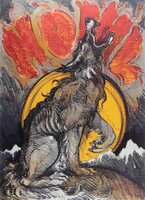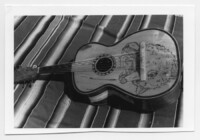Search Results
Subject is exactly
Wolves
Use buttons below to view additional pages.
-

Howl
title Howldescription Color lithograph on paper, 44.5 in. x 34 in. Luis Jiménez portrays a lone wolf howling at the full moon that rises above snow capped mountains. The wolf’s howl is transformed into the title of the work. Wolves, like this Mexican wolf, communicate with their pack by howling; this vocalization communicates their location and marks their territory; serves as a warning to rivals or signals a threat of intruders. Besides expressing affection through their howling, wolves express other emotions. Here, the “howl” vibrates above, resonating with rage, pain, and warning. Jiménez used the color red to emphasize these strong emotions. Note that the letter “l” in the word “howl” resembles the wolf’s raised right paw. The wolf is enraged as his species is endangered. Humans continue to hunt wolves for pelts and bounty. The wolf also painfully mourns the vanishing Western landscape and the diminishing presence of the Original Americans. The howl is a warning to humanity to protect and preserve the natural landscape and animal life. The Mexican wolf also symbolizes how Mexican immigrants have been hunted by the border patrol and vigilantes at border crossings. This work is a visual metaphor for the artist Jiménez, who for years before he gained critical recognition was perceived as an outsider: a “lone wolf.” Born in El Paso, he was an artist fiercely proud of his Mexican roots who celebrated the everyday culture of the Southwest. He howled especially for his people, Mexicans and Chicanos, and their ongoing struggle for social mobility and social justice in the borderland and beyond. Proud of his Chicano roots, Luis Jiménez (1940 – 2006) was an El Paso, Texas native, best known for his large-scale, brightly colored sculptures immersed in the Chicano iconography of Texas and New Mexico. Jiménez studied art and architecture at The University of Texas in Austin and El Paso. He eventually traveled to Mexico to study the famous Mexican muralists Diego Rivera and José Clemente Orozco, and was also influenced by regionalists Thomas Hart Benton and Grant Wood. After completing school, he went to work for his father making neon signs and car decals. In 1966 Jiménez moved to New York and joined the Pop Art scene, making painted fiberglass figurative works inspired by the everyday lives of Latinos living in the Southwest. His work shows his concern for working-class people and those who have suffered from discrimination. Jimenez was and remains respected in Latino communities for his perspective and narrative of the culture of Mexico and the Southwest. His artwork emulates popular Cholo car culture, demonstrated in his use of fiberglass, spray paint, and imagery consisting of Aztec emperors, border crossing, and vaqueros riding wild broncos. His works are in the collections of the Albuquerque Museum, the Smithsonian American Art Museum in Washington, D.C., the El Paso Museum of Art, the Metropolitan Museum of Art in New York, the Art Institute of Chicago, and the Museum of Fine Arts in Houston, among others.artist/creator Jiménez, Luissubject Borderlands Frontera Animals in art Wolves Environment Ecology Nature in art Color lithographs Lithographs Prints Life and Experiences in the U.S./Mexico Borderlands (exhibition)contributor Mexic-Arte Museum (MAM) -

Guitar With Wolf Illustration
title Guitar With Wolf Illustrationdescription Photograph of a guitar with a wolf illustration on the top part of the body. A label on its side indicates that it belongs to the La Joya Independent School District.artist/creator Graham, Joe Stanley, 1940-1999subject La Joya Social Life And Customs Guitars Arts And Crafts - Music La Joya Independent School District Places - United States - Texas - Hidalgo County Illustrations Wolves Arts And Crafts - Drawingscontributor Portal to Texas History (TPTH)